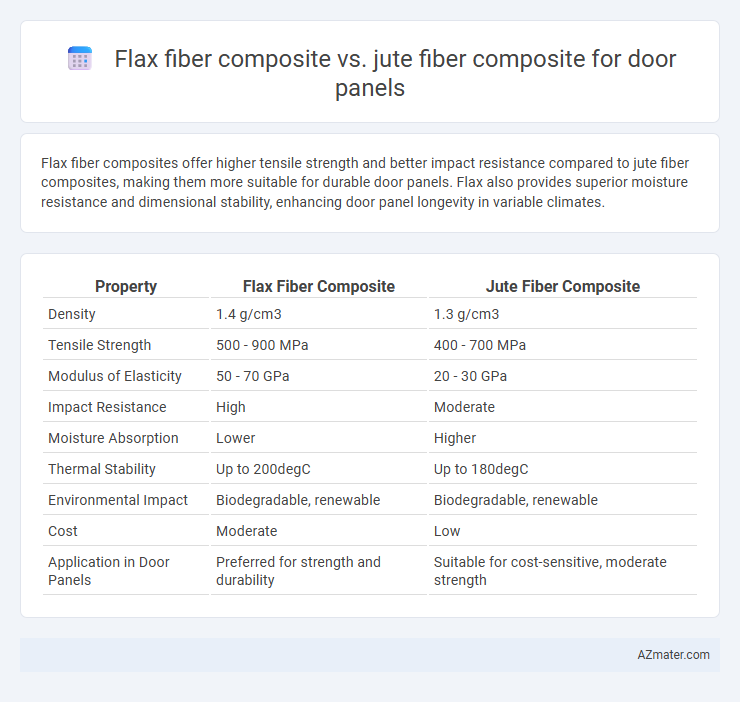Flax fiber composites offer higher tensile strength and better impact resistance compared to jute fiber composites, making them more suitable for durable door panels. Flax also provides superior moisture resistance and dimensional stability, enhancing door panel longevity in variable climates.
Table of Comparison
| Property | Flax Fiber Composite | Jute Fiber Composite |
|---|---|---|
| Density | 1.4 g/cm3 | 1.3 g/cm3 |
| Tensile Strength | 500 - 900 MPa | 400 - 700 MPa |
| Modulus of Elasticity | 50 - 70 GPa | 20 - 30 GPa |
| Impact Resistance | High | Moderate |
| Moisture Absorption | Lower | Higher |
| Thermal Stability | Up to 200degC | Up to 180degC |
| Environmental Impact | Biodegradable, renewable | Biodegradable, renewable |
| Cost | Moderate | Low |
| Application in Door Panels | Preferred for strength and durability | Suitable for cost-sensitive, moderate strength |
Introduction to Natural Fiber Composites in Automotive Applications
Natural fiber composites, such as flax and jute fibers, are increasingly utilized in automotive door panels due to their lightweight, renewable, and biodegradable properties. Flax fiber composites offer higher tensile strength and stiffness compared to jute, enhancing durability and impact resistance in automotive applications. Jute fiber composites provide cost-effectiveness and good vibration damping, making them suitable for environmentally friendly door panel production while contributing to reduced vehicle weight and improved fuel efficiency.
Overview of Flax Fiber Composites
Flax fiber composites offer a lightweight and sustainable alternative for door panel manufacturing, characterized by high tensile strength and excellent vibration damping properties. These composites provide enhanced durability and resistance to moisture compared to jute fiber composites, making them suitable for automotive and furniture applications requiring long-term performance. The natural origin and biodegradability of flax fibers contribute to an eco-friendly profile while maintaining mechanical integrity in composite materials.
Overview of Jute Fiber Composites
Jute fiber composites offer excellent biodegradability, low density, and good mechanical properties, making them suitable for eco-friendly door panel applications. These composites exhibit high tensile strength and stiffness, with favorable acoustic and thermal insulation characteristics compared to synthetic alternatives. Their cost-effectiveness and renewable nature drive increasing adoption in automotive and building industries focused on sustainable materials.
Mechanical Properties: Flax vs Jute Fiber Composites
Flax fiber composites exhibit higher tensile strength and stiffness compared to jute fiber composites, making them more suitable for structural applications such as door panels requiring durability and load-bearing capacity. The elongation at break in flax composites is lower, indicating better dimensional stability under stress, while jute composites provide moderate mechanical performance but with superior impact resistance. Flax's superior fiber-matrix adhesion enhances its mechanical properties, resulting in improved wear resistance and longevity in door panel applications.
Thermal and Acoustic Insulation Performance
Flax fiber composites exhibit superior thermal insulation properties compared to jute fiber composites, reducing heat transfer and maintaining stable indoor temperatures in door panels. Jute fiber composites offer enhanced acoustic insulation by effectively dampening sound waves, making them suitable for noise reduction applications. Both materials provide sustainable alternatives, but flax excels in thermal performance while jute leads in sound absorption for door panel designs.
Environmental Impact and Sustainability Comparison
Flax fiber composites exhibit lower carbon footprints and higher biodegradability compared to jute fiber composites, making them a more environmentally sustainable option for door panels. Flax fibers require less water and fertilizer during cultivation, contributing to reduced resource depletion and soil degradation. Jute composites, while biodegradable, involve higher energy consumption in processing, which can offset some environmental benefits relative to flax-based materials.
Cost Analysis: Flax vs Jute Composites
Flax fiber composites generally exhibit higher material costs compared to jute fiber composites due to their superior mechanical properties and more complex processing requirements. Jute fiber composites offer a cost-effective alternative with lower raw material prices and simpler manufacturing processes, making them suitable for budget-sensitive door panel applications. However, the overall cost-effectiveness depends on factors such as durability, weight, and performance requirements specific to automotive or construction door panels.
Processing and Manufacturing Considerations
Flax fiber composites offer superior compatibility with resin matrices during processing, resulting in enhanced fiber wetting and reduced void content compared to jute fiber composites. Manufacturing door panels with flax fibers benefits from lower moisture absorption and improved thermal stability, enabling higher processing temperatures and better dimensional stability. In contrast, jute fiber composites require additional treatments to mitigate moisture sensitivity, which can complicate manufacturing and affect long-term durability in automotive applications.
Case Studies: Door Panel Applications
Case studies on door panel applications reveal that flax fiber composites offer superior mechanical strength and impact resistance compared to jute fiber composites, enhancing durability in automotive interiors. Flax composites exhibit lower moisture absorption, resulting in improved dimensional stability and longevity under varying environmental conditions. Jute fiber composites, while more cost-effective, tend to show higher susceptibility to fungal degradation and reduced structural integrity over time in door panel applications.
Conclusion: Choosing the Optimal Fiber Composite for Door Panels
Flax fiber composites offer superior mechanical strength, durability, and moisture resistance compared to jute fiber composites, making them more suitable for door panel applications requiring enhanced structural integrity. Jute fiber composites provide cost-effective and eco-friendly alternatives but may compromise on long-term performance and resistance to environmental factors. Selecting the optimal fiber composite hinges on balancing performance requirements, environmental conditions, and budget constraints specific to door panel manufacturing.

Infographic: Flax fiber composite vs Jute fiber composite for Door panel
 azmater.com
azmater.com